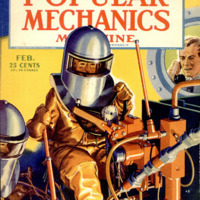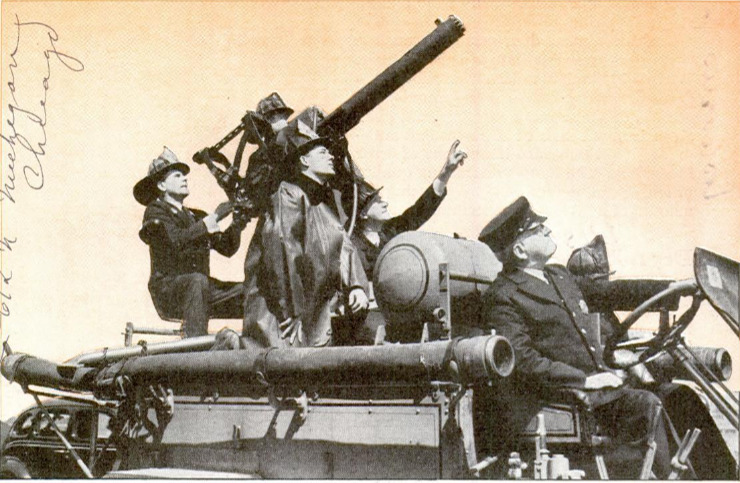AGENTS o the Federal Bureau of Investigation were hunting danger spots in a wharf area at Hoboken, N. J. The fire protection plans seemed complete. One company had installed 97 barrels of water, and above each a bucket labeled “Fire.” The G-men noticed that every barrel was brimful - but the surface looked suspiciously oily. Investigation developed that each barrel was topped with five gallons of fuel oil. A bucket of that “water” thrown on a small fire might have started a conflagration. Sabotage? No. There had been trouble with mosquitoes, and an exterminating company had doused the barrels with oil to stop mosquito breeding. Throughout the country the Bureau of Investigation has been surveying defense industries for fire hazards, incendiary or natural. Other agencies, oo, are martialing forces against fire. All firefighting forces in Maryland are being coordinated for mutual assistance among cities in emergencies. The Massachusetts State Fire Marshal - partly under the spur of the hurricane of 1938 which cost more than 500 lives and found few communities prepared for rescue work - has taken a statewide inventory of fire department equipment. When fire or flood or sabotage occurs, necessary equipment can be located instantly. In several regions, notably coastal cities, airplane watchers and fire spotters are being organized after the British rooftop watch system. Readying for war? Not necessarily. For defense, yes - defense against fire. For fire is the great destroyer in war, as in peace, and government and industry are taking all possible steps to prevent fire, incendiary or otherwise, in defense factories. One of the toughest hazards the war has brought, both in Europe and America, is the magensium fire. Abroad it is the most paralyzing of aerial weapons. Here, increasing use of magnesium alloys in aircraft construction has multiplied the chances of factory fires, and the peculiarities of this combustible metal have multiplied the problems of fire fighters. Trying to smother a magnesium blaze with water is like spraying a fire with gasoline. British firemen had to learn this treacherous characteristic of magnesium through disastrous experience. One fire started in a shed housing 15 tons of magnesium scrap. Firemen turned 20 hoses on the blaze. Feeding on oxygen in the water, the magnesium exploded violently, 14 men were injured, and the flames spread to sheds containing aluminum scrap and burned for 48 hours. Sparks from a tool set fire to magnesium turnings in a New Jersey plant. The fire was almost quenched by smothering it with tale when a sprinkler opened, the water washed off the talc and intensified the fire. Incendiary bombs were used in the first world war, but they were not very effective. Thermit bombs, steel shells filled with a mixture of aluminum powder and iron oxide which burns violently when ignited, often burnedout soon after the heat penetrated the steel skin. But the new “electron bomb” has proved horribly efficient. It weighs only two pounds, and a bombing plane can carry 2,000. It can penetrate four inches of reinforced concrete; the chances are it will pierce the roof and Todge in the attic, often a difficult place to fight fire. Its thermit center is ignited-by-a percussion cap on impact, burning for perhaps a minute at 4,532 degrees Fahrenheit. Instead of a steel shell its covering is magnesium, and jets of flame from the thermit core shoot from vents in the shell, scattering bits of molten magnesium for 50 feet. Then the magnesium shell burns brilliantly 10 or 15 minutes. These are the flame pellets that have made blackened shells of British factories, homes, stores and historic shrines. They would do worse. here, if the aerial “plitz” came to America; for wooden shingle roofs, which have disappeared in most of Europe, are a dangerous conflagration element in the United States. There is, of course, a percentage factor in favor of the defense. A bomber may carry 1,000 to 2,000 electron bombs; but it is estimated that only 15 percent of the ground space of an urban area is covered by buildings, so that about 150 of 1,000 bombs dropped would hit buildings. Of these, probably half would glance off or fail to penetrate the roof, and perhaps only 75 fires would result. A plane flying 200 miles an hour at 5,000 feet would drop 1,000 bombs, 20 per second, within three miles, setting fires every 60 vards. Multiply that by 100 or more planes and you conceive the burden Talling on fire watchers. Buildings can be protected by reinforcing roof timbers and flooring to prevent the bomb from penetrating, covering the flooring with some fire-resistant material - two inches of dry sand, brick dust, asbestos board or similar substance - and providing proper fire extinguishers, as described below. Water and other common agents - foam, carbon dioxide, carbon tetrachloride, sodium bicarbonate - are worse than useless against burning magnesium. They intensify the flame. Water reacts with magnesium to produce hydrogen - itself a flammable gas - and magnesium hydroxide. Water feeds oxygen to the flames more rapidly than does air. British fire fighters use snuffers - invered bowls of wire mesh sprayed with asbestos - to prevent spread of the fire. They also use long-handled claws to grip the bomb and remove it. Powdered graphite, tale or similar substance inert to magnesium will help localize the flamesby smothering. Properly used, water will hasten the burning of the bomb itself and prevent spread of the fire to surrounding combustibles. Automatic sprinklers are useful for wetting down the surroundings, especiallyif the fire is small, as around magnesium machining operations where chips masignite. The latest and perhaps most-effective material for fighting magnesium flames is a dry powder developed by Dow Chemical company, a leaéfiiz manufacturer of magnesium alloys, and Pyrene Manufacturing company. It is a non inflammable, powder inert to magnesium containing small amount of material which forms heavy vapor when heated and shuts out air. The National Fire Protection Association is leading a preparedness campaign against fire and sabotage. In a handbook, “Fire Defense,” it has compiled information on the organization of fire wardens, how to fight various types of fires, the handling of bombs, maintenance of water supply and communidations in emergency. Breakdowns of water lines and communication systefns are hazards that must be anticipated. Automatic sprinkler systems are essential, yet they can be nullified by failure of th¢ water supply. A plywood plant in Washi-fgmn was destroyed with a $525,000 loss and two employes were burned to death. Afterward the sprinkler system valve was found almost closed. Similarly, a Massachusetts mill was wiped out by fire while its sprinklers were disconnected. Fire brigades in factories must know where the valves are located and how to get water if the usual supply fails. In an air raid, when mains are broken, firemen must cut off the waste by closing valves, then pump from the nearest stream or pond. Authorities state that practically no city in the United States has enough fire alarm boxes. Signaling and communication systems must be made proof against interruption by any cause, even the seemingly impossible air raid. Police and fire departments are rapidly being equipped with radio, and in this way are well prepared. America, we hope, will escape aerial bombing. One high explosive 2,200-pound bomb demolished four English houses, seriously damaged 20 more within 200 feet and partly wrecked 119 others. The explosives America is alert for are the infernal machines of the saboteur. There is no absolutely safe way even for an expert to handle an unexploded bomb. it is a popular and dangerous notion that a bomb can be rendered harmless by “dunking” it in water. Actually, water may detonate the bomb. Water may short-circuit its electric mechanism. The bomb may be made of a metal that bursts aflame when water touches it. The fuse of a dynamite bomb may be waterproof. If a quenching agent is essential, light lubricating oil or kerosene would probably stop any clockwork mechanism. But nothing is quite safe. A bomb expert was called to a post office to investigate a suspicious package. He took every precaution: working with special manipulators from behind an armored steel shield, he watched through a periscope as he endeavored to render the bomb harmless. But it exploded, drove the shield against the wall and crushed him. When a bomb is discovered, get an expert. Open all windows and doors to let the blast escape. Use sandbags or mattresses to stop flying fragments. Remove flammable materials, shut off gas and other utility lines. If it is possible to move the bomb out of a building, drag it on a rope at least 50 feet long, but avoid any jar. Sabotage is less likely to occur if we are alert to prevent it and ready to combat fire and explosions effectively where they do break out. And the nation that is ready to fight the incendiarist will be better prepared in peace to fight the annual toll of $300,000,000 in fire losses.
 Popular Mechanics, vol. 77, n. 2, 1942
Popular Mechanics, vol. 77, n. 2, 1942





